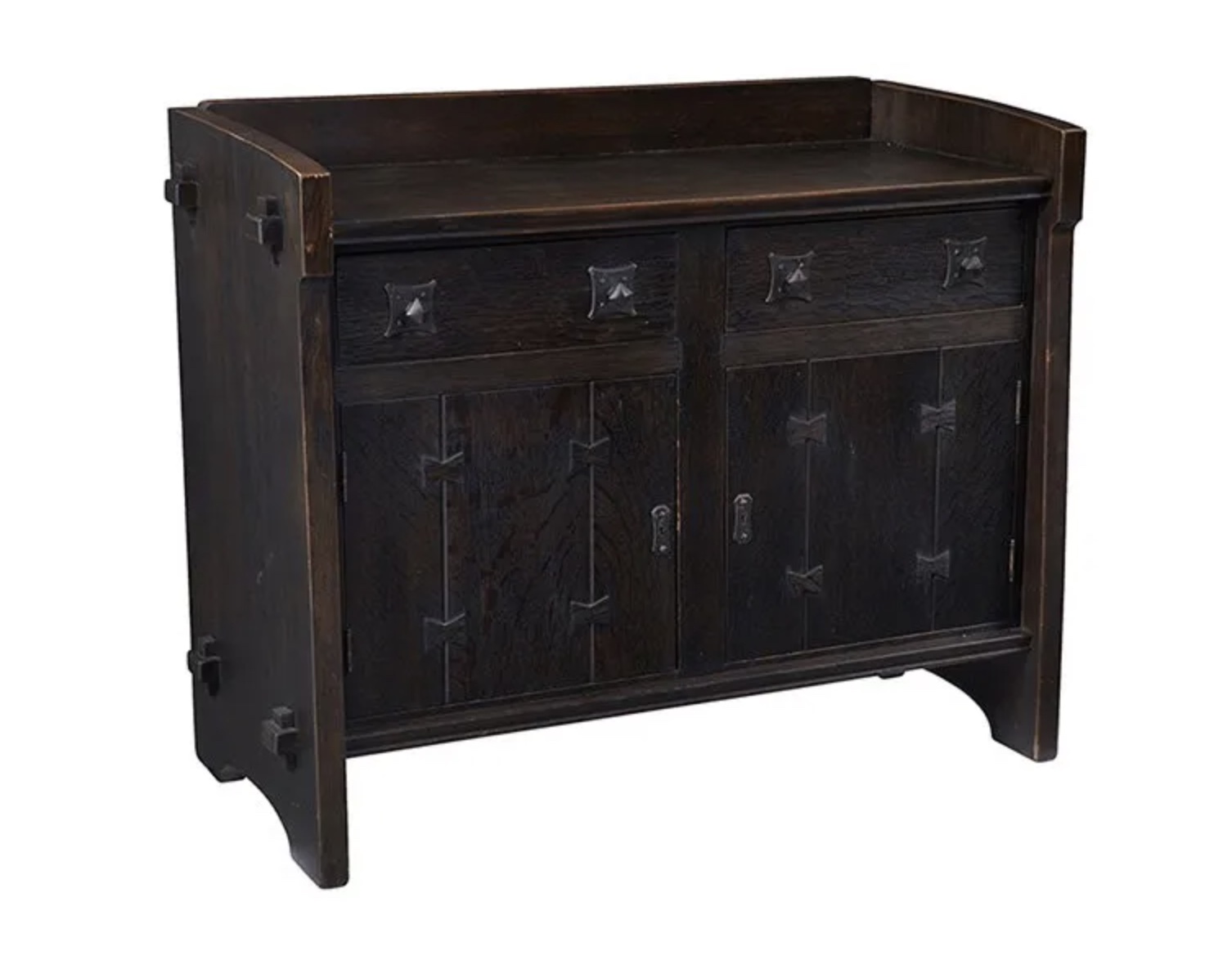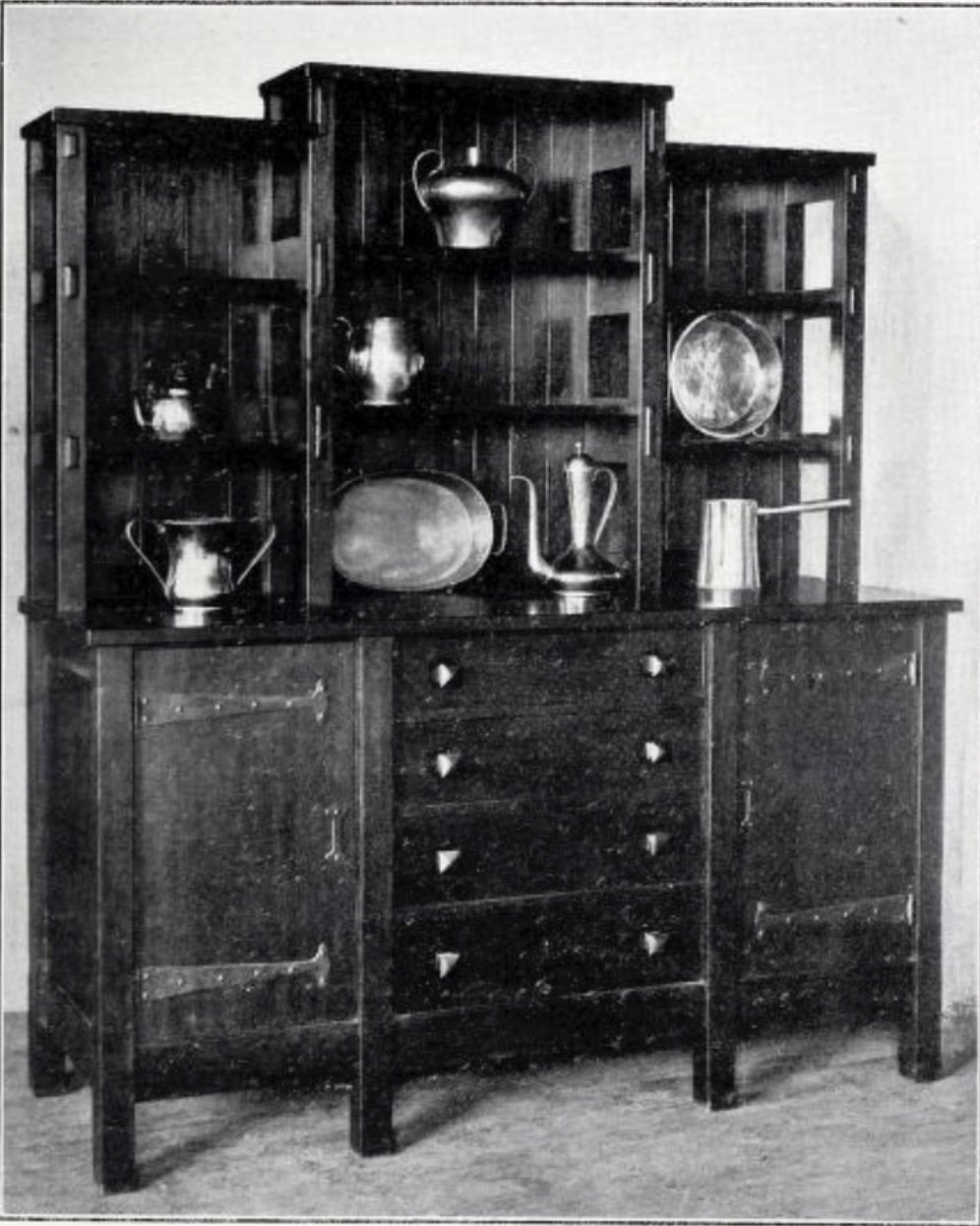A sideboard, also known as a buffet or credenza, is a piece of furniture typically found in dining rooms or kitchens. It serves both functional and aesthetic purposes, providing additional storage space while also contributing to the overall design of a room.
For more information on how we determine prices click here.

Strap-Hinge Sideboard, #814, c1910; 66"h x 48"w x 23"d.
Photo courtesy of California Historical Design.
In its earlier 1902 iterations, the 814 sideboard exhibited a robust design with through tenons securing the bottom and top horizontal rails on the sides and the front. Over time later versions became less chunky, with diminishing attention to details such as tapering legs and the adoption of thinner cuts of wood.
Various versions of this fundamental design were produced throughout the company's history with different catalog numbers, primarily measuring 56 and 66 inches in length, although other sizes exist. The sideboard illustrated above features strap hinges, yet alternatives were crafted without straps and occasionally included an open cubby or other different storage configurations. As with other forms, the sideboards were equipped with either copper or iron hardware.
It is important to note that the large veneer panels on the sides and cupboard doors are susceptible to issues such as separation, cracks, and overall loss, warranting careful consideration of condition when assessing these pieces.
Price Range: $1,500 - $12,000

Sideboard with Arched Apron, #804, 1904-7; 54.5"h x 43.5"w x 22"d.
Photo courtesy of California Historical Design.
This sideboard, a creation of Harvey Ellis, is distinguished by its signature long sweeping arch and sides made up of robust slabs. Produced from 1903 to approximately 1907, it was available in different sizes: 54, 72, and 66 inches. The sideboards consistently featured copper or iron hardware, with the form above adorned with copper.
In terms of storage, the ample space maintained a consistent configuration of drawers, except for a unusual variant with drawers at the top and an exceptionally large open shelf at the bottom. Ellis's timeless design ensures this sideboard stands out as a hallmark of craftsmanship from the early 20th century.
Price Range: $3,000 - $25,000

The Butterfly Sideboard, #901, 1901; 40"h x 50"w x 23"d.
Photo courtesy of Treadway Toomey Auctions.
The Butterfly Sideboard derives its name from the distinctive butterfly-styled joints that secure the front boards, making it highly coveted among serious collectors. Its appeal lies in the honesty of construction, a departure from the previously popular intricately carved Victorian furniture. While serving as a decorative element, the butterfly joints also play a functional role in the overall design.
These sideboards are typically found in a dark to black finish. The design showcases meticulous attention to detail in every cut of wood. In early pieces, such as the one depicted above, even the edges of the top and bottom horizontal boards exhibit thoughtful molding.
Approximately 25 years ago at Grove Park's National Annual Arts & Crafts Conference, Dave Rudd of Dalton Antiques presented a pristine example of this form. Upon inspection, Robin and I hesitated on the purchase and left the booth, only to realize moments later that we should purchase it for our collection. Unfortunately, we failed to secure the sideboard by requesting Dave hold it for us for a few minutes, leading to a missed opportunity. As we turned back to the booth legendary collectors, Bill and Patsy Porter, were wielding their checkbooks, and the piece was gone. This just goes to show the importance of quick decisions and the power of putting pieces on brief holds.
Price Range: $5,000 - $85,000

Eight Leg Sideboard, 1901-2.
Photo courtesy of the May 1902 Craftsman.
The holy grail of Gustav Stickley sideboards, this specimen is an unparalleled rarity, with only one known example found by some extremely lucky collectors. The saga began when the top shelved section surfaced at a Skinner Auction in Boston, initially deemed virtually worthless without its counterpart. Fortunately, luck struck when an early eight-legged sideboard, missing its plate rail and featuring drilled holes into the top, appeared at Grogans auction also in Boston a few months later. The collectors, informed by a dealer, made a decisive move to acquire the matching bottom, discovering upon reuniting the two halves that the original top had round dowels perfectly fitting into the holes in the bottom of the sideboard. Beyond its unique story, this sideboard stands out as a functionally beautiful display item.
The foundational eight-leg form, attributed to designer Lamont Warner, was in production from 1901 until the end of Stickley's production. The earliest examples boasted solid oak doors and more intricate hardware. The bodies of earlier variations are approximately two inches closer to the ground, with plate rails about two inches taller compared to their later counterparts. The earliest examples also have pyramidal wooden knobs on the draws. Furthermore, the earlier versions are crafted from solid wood, while later eight-leg sideboards feature veneer.
Due to its unmatched uniqueness, the sideboard illustrated is a coveted item among collectors, with no other known example of an eight-leg sideboard featuring this type of shelving.
Price Range: N/A
